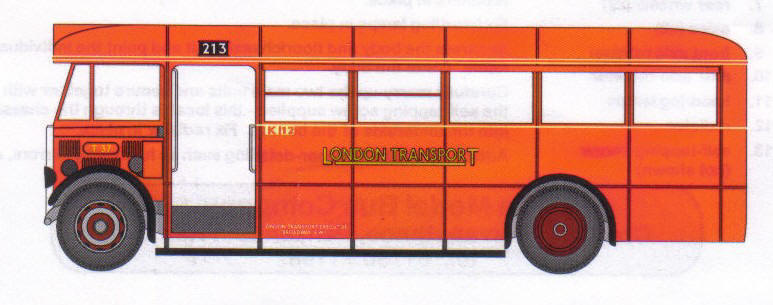
1T1/1
MARSHALL REBUILD FROM THE MODEL BUS COMPANY - KIT NO. 4
Review by Alan Purssey
18 months ago Graham Orchard of the M.B.C. released two models
under his own brand name.
 These two models were based on the 1929
AEC Regal 662 chassis. The first based on the 30-seat single deck bus
with a door less rear entrance built by General in 1929 T31 is an
example preserved at Cobham Bus Museum.
These two models were based on the 1929
AEC Regal 662 chassis. The first based on the 30-seat single deck bus
with a door less rear entrance built by General in 1929 T31 is an
example preserved at Cobham Bus Museum.
A number of these vehicles were rebuilt with front entrances; from May
1933 to March 1935 this was the subject of the second model.
 By
the late forties there was an acute vehicle shortage and the
timber-framed bodywork on many vehicles were showing there age. 18 of
the front entrance Regals were refurbished by Marshall’s of Cambridge
to prolong their lives until replaced in 1953. This is the subject of
his latest model Classified 1T1/1 circa 1948. There are some minor
differences in body detail to the original.
By
the late forties there was an acute vehicle shortage and the
timber-framed bodywork on many vehicles were showing there age. 18 of
the front entrance Regals were refurbished by Marshall’s of Cambridge
to prolong their lives until replaced in 1953. This is the subject of
his latest model Classified 1T1/1 circa 1948. There are some minor
differences in body detail to the original.
The deep side moulding was removed from beneath the windows, and above
the skirt line. The broad band around the roofline was also removed and
replaced with a double beading. The overall appearance gave these buses
a smoother outline. All were painted in the post war livery of all over
red with the beading in cream; a similar treatment was afforded to some
of the LT Scooters the subject of a model from the L.B.C. last year.
All eighteen buses were allocated to Kingston garage (K) for service on
routes 201, 218.and 264.
The
model numbered 4 in the series comes in a stout box with a colour
illustration on the lid. The instructions are collectable in their own
right, and include a brief history plus a front and side colour guide to
aid painting, and transfer application. The reverse side shows an
explicit cut away diagram in colour displaying all the parts.
The
kit comprises a one-piece resin body shell, plus a chassis-seating unit.
Cast metal parts include the steering wheel, radiator, headlight and
spotlight unit, step, and bonnet side, and axle retainers. Wheels are
push fit from the L.B.C. range. The resin body is very finely detailed
to scale proportions, with all the fine body panel joints, down to the
used ticket box in the entrance. Graham has very cleverly replicated the
double beading around the roofline to make this an astounding model.
At first sight it looks rather daunting to paint, but after cleaning off
any moulding flash, prime the model first: this helps show any point
that has been missed.
I then painted the cream
lining
first, and when its dry, set about the red main coat up to the lining.
The beading
is proud enough to give a straight line. After painting cut and add the
glazing material provided in the kit before final assembly of the
chassis unit. A self-tapping screw is provided to attach the chassis
unit to the body shell.
To super detail the model items such as wing mirrors can be added
together with fine wire to represent the
handles.
A transfer of the Beclawat emergency rear door handle is included and
should be fitted with the point facing down on the right hand side of
the door just below the beading.
Transfers to complete the model as T37 on route 213 are available
separately and include registration plates, legal lettering, destination
screen, garage plates, and come post free if ordered with the kit.
This is defiantly one for the more mature modeller! (especially those
like myself who can remember the vehicles in service running out of
Kingston Garage).
Alan Purssey